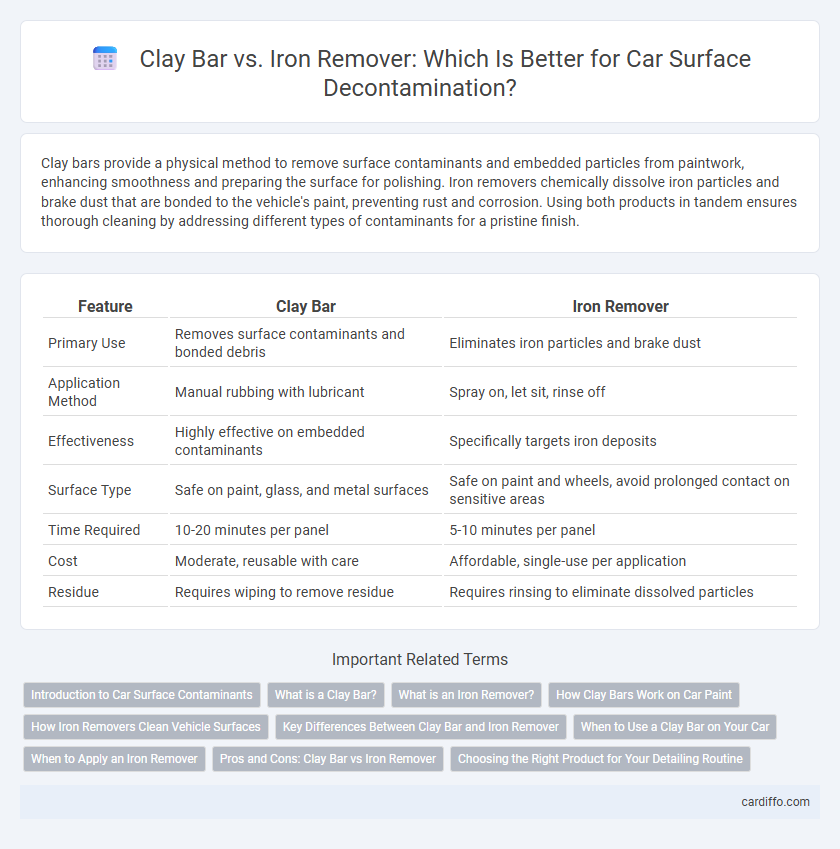Clay bars provide a physical method to remove surface contaminants and embedded particles from paintwork, enhancing smoothness and preparing the surface for polishing. Iron removers chemically dissolve iron particles and brake dust that are bonded to the vehicle's paint, preventing rust and corrosion. Using both products in tandem ensures thorough cleaning by addressing different types of contaminants for a pristine finish.
Table of Comparison
| Feature | Clay Bar | Iron Remover |
|---|---|---|
| Primary Use | Removes surface contaminants and bonded debris | Eliminates iron particles and brake dust |
| Application Method | Manual rubbing with lubricant | Spray on, let sit, rinse off |
| Effectiveness | Highly effective on embedded contaminants | Specifically targets iron deposits |
| Surface Type | Safe on paint, glass, and metal surfaces | Safe on paint and wheels, avoid prolonged contact on sensitive areas |
| Time Required | 10-20 minutes per panel | 5-10 minutes per panel |
| Cost | Moderate, reusable with care | Affordable, single-use per application |
| Residue | Requires wiping to remove residue | Requires rinsing to eliminate dissolved particles |
Introduction to Car Surface Contaminants
Car surface contaminants include iron particles and bonded impurities that degrade paint finish and promote corrosion. A clay bar physically removes bonded contaminants by gently shearing them from the surface, while iron removers chemically dissolve embedded iron deposits for deeper cleaning. Combining both methods enhances paint clarity and prepares the surface for polishing or sealing.
What is a Clay Bar?
A clay bar is a detailing tool made from a synthetic resin compound designed to remove embedded contaminants from automotive paint surfaces. It effectively lifts dirt, tar, industrial fallout, and other pollutants that regular washing cannot eliminate, restoring a smooth and clean finish. Unlike iron removers, which chemically dissolve iron particles, a clay bar physically extracts contaminants, providing a tactile method for deep surface cleaning.
What is an Iron Remover?
Iron remover is a specialized cleaning product designed to eliminate iron deposits, brake dust, and other ferrous contaminants from vehicle surfaces without scratching the paint. Unlike clay bars that physically remove particles through friction, iron removers chemically dissolve embedded iron particles, making them easier to rinse away. Using iron remover enhances paint clarity and prepares the surface for polishing or waxing by effectively addressing microscopic iron contaminants.
How Clay Bars Work on Car Paint
Clay bars work on car paint by gently lifting and removing embedded contaminants such as brake dust, industrial fallout, and environmental pollutants that cannot be eliminated with regular washing. The malleable clay material molds to the surface, pulling out impurities stuck beneath the clear coat without damaging the paint. This process results in a smooth, clean surface that enhances the longevity of wax or sealant applications.
How Iron Removers Clean Vehicle Surfaces
Iron removers clean vehicle surfaces by chemically bonding with iron particles embedded in the paint, effectively breaking them down and allowing for easy removal without damaging the clear coat. These products contain active agents like chelating compounds that dissolve ferrous metals and brake dust contaminants, restoring a smooth, contaminant-free finish. Unlike physical abrasion methods such as clay bars, iron removers provide a more targeted and less labor-intensive solution for eliminating iron deposits.
Key Differences Between Clay Bar and Iron Remover
Clay bars physically remove bonded contaminants like tar, sap, and overspray from vehicle paint surfaces, restoring smoothness and enhancing paint clarity. Iron removers chemically dissolve iron particles such as brake dust and rail dust, preventing rust formation and staining without abrasive action. Clay bars require manual rubbing and water lubrication, whereas iron removers are sprayed on and washed off, making them complementary products in automotive detailing.
When to Use a Clay Bar on Your Car
Use a clay bar on your car when the paint surface feels rough or contaminated with bonded particles that washing alone can't remove, such as overspray, tree sap, or industrial fallout. Clay bars are ideal for smoothing the surface before applying polish or wax, ensuring a clean, smooth finish. Unlike iron removers that target embedded iron particles, clay bars physically lift a wide range of contaminants from the clear coat.
When to Apply an Iron Remover
Apply an iron remover before using a clay bar to effectively dissolve embedded iron particles and brake dust that a clay bar alone cannot fully remove. Iron removers are best used on painted surfaces, wheels, and glass to prevent surface contamination and staining. Using an iron remover first ensures the clay bar glides smoothly, reducing the risk of scratches and enhancing the overall cleaning process.
Pros and Cons: Clay Bar vs Iron Remover
Clay bar effectively removes surface contaminants like tar, tree sap, and overspray, providing a smooth finish but requires more time and effort compared to iron remover. Iron remover excels at dissolving embedded iron particles and brake dust from paint and wheels, offering a quick and chemical-free solution, yet it may not address other types of surface impurities. Combining clay bar and iron remover in a cleaning regimen ensures comprehensive contaminant removal but demands knowledge of proper application to avoid paint damage.
Choosing the Right Product for Your Detailing Routine
Selecting between a clay bar and an iron remover depends on the type of contaminants present on your vehicle's surface; clay bars are ideal for eliminating bonded dirt, tree sap, and industrial fallout, while iron removers specifically target embedded iron particles such as brake dust. Incorporating a clay bar into your detailing routine provides a smooth, contaminant-free surface perfect for waxing, whereas iron removers chemically dissolve iron deposits without scrubbing, making them essential for areas prone to iron buildup. Evaluating the extent and nature of contamination helps determine the most effective product, ensuring optimal paint correction and long-lasting finish protection.
Clay Bar vs Iron Remover Infographic

 cardiffo.com
cardiffo.com